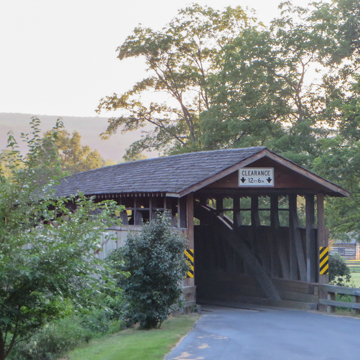Old Bedford Village is a living history museum. Opened in 1976, it displays nearly forty pre-twentieth-century structures from central Pennsylvania. The nearly treeless site is adjacent to two major highways and the Raystown Branch of the Juniata River. The Claycomb covered bridge, originally built in 1880 nearly fifteen miles farther north, was moved to the site in 1975 to provide access across the river. The buildings, moved from their original sites, were reerected here along modern curved streets, rather than in the crossroads configuration prevalent prior to 1860.
Especially interesting is the small log house (c. 1758), from midway between Bedford and Cumberland, Maryland, that the museum's historians believe was built under orders from Colonel Henry Bouquet, the Swiss-born British officer who was second-in-command of Pennsylvania's troops between 1758 and 1764. This type of log house, with a single door and window on the long wall and an interior end chimney at the gable end, is rare. Another building at the site, the South Woodbury log house, appears to have been built by Henry Ober in c. 1828, using a corner-post technique seen most often among Swiss Mennonites in Lancaster. In this technique, a corner log is mortised to accept each log, rather than notching the logs to lay one above the other. The two-story, four-bay log house has a large, vertical-sided addition on the rear elevation.
The one-story octagonal school built by Hiram Way in 1851 for Fishertown retains the original slate blackboard and a number of artifacts from the school. The benches along seven walls and the central potbelly stove are accurate reproductions. The advantages of an octagon shape included better sightlines for the teacher and better light and heat distribution for the students. This structure was used as a school until 1933.
Archaeologically, the site holds remains of the Monongahela people dating from 1200 to 1300 CE; it appears that they built a stockaded village here and remained for fifty years. The village is listed on the National Register of Historic Places for its archaeological remains.


